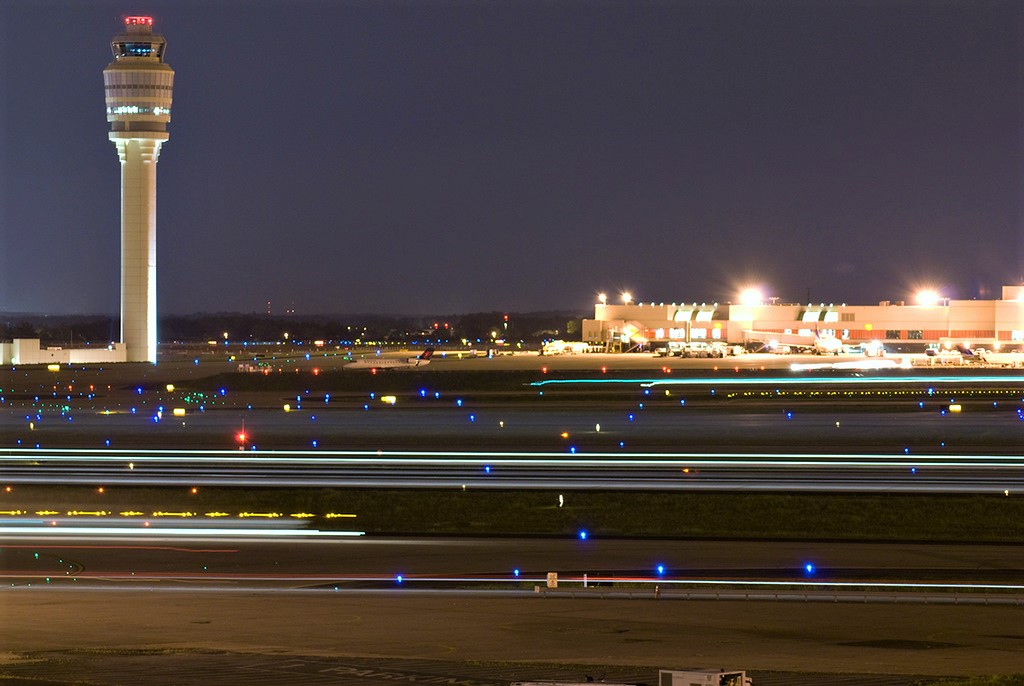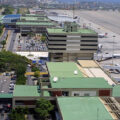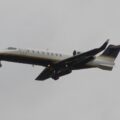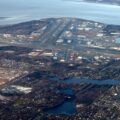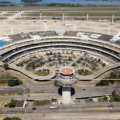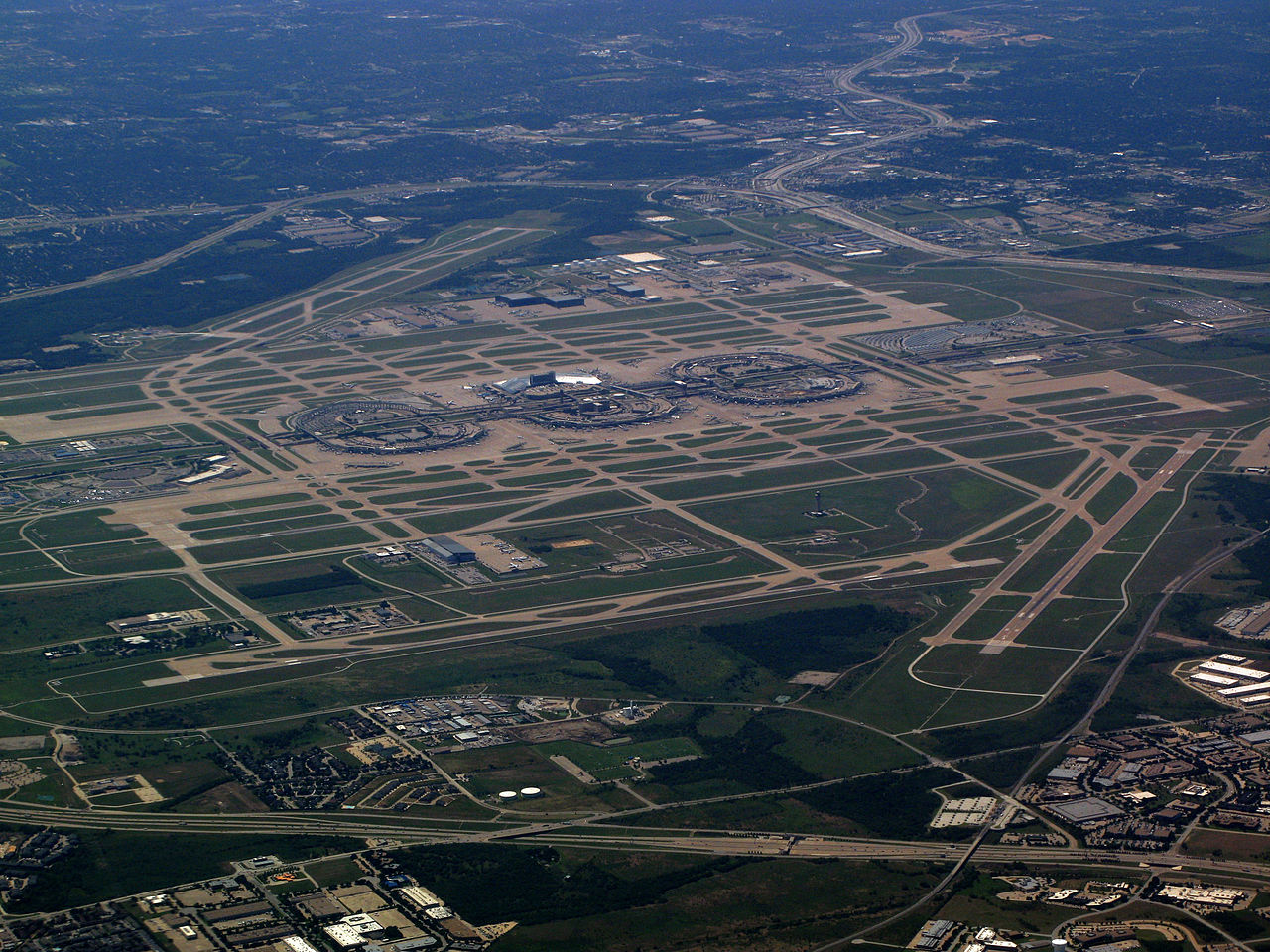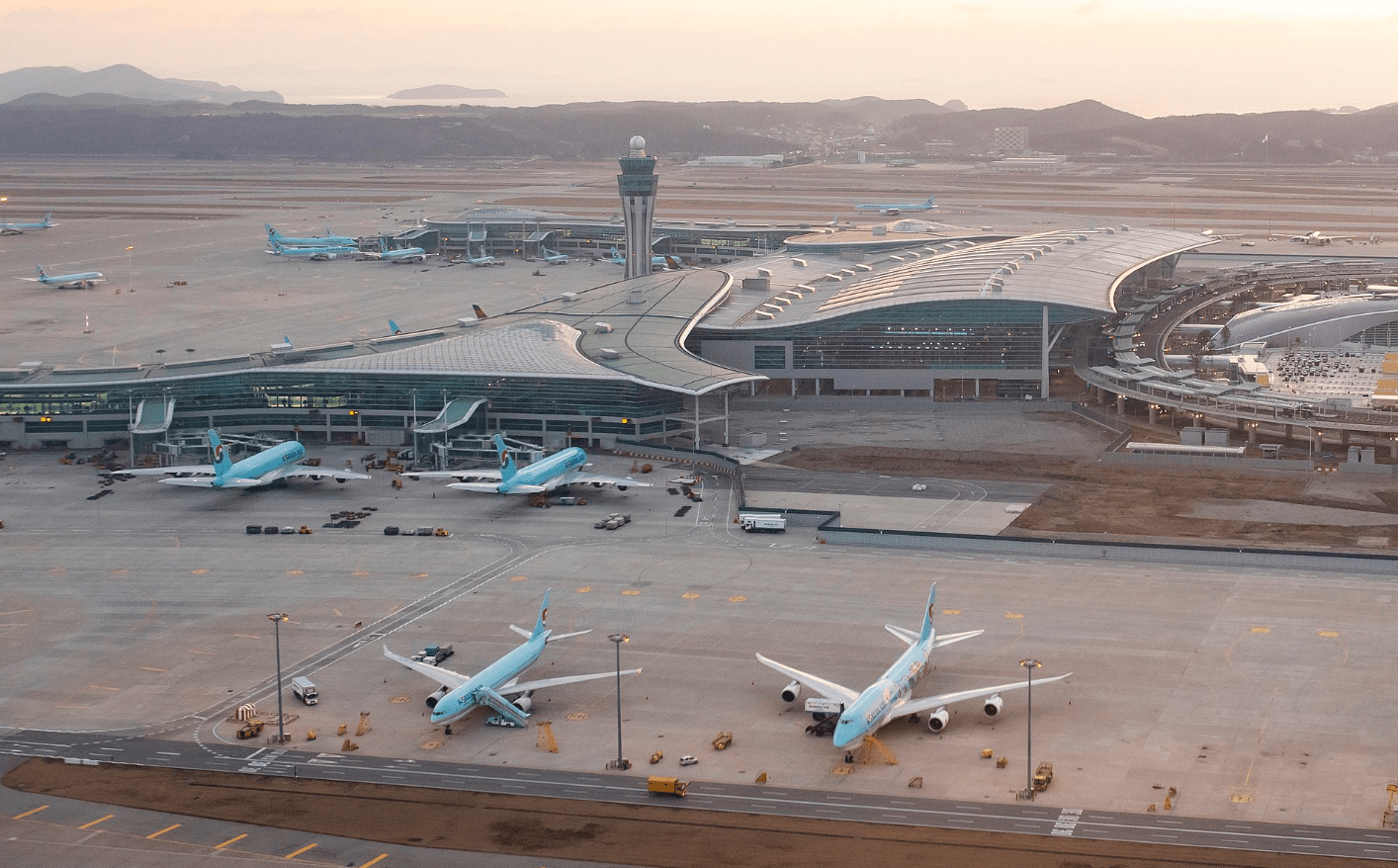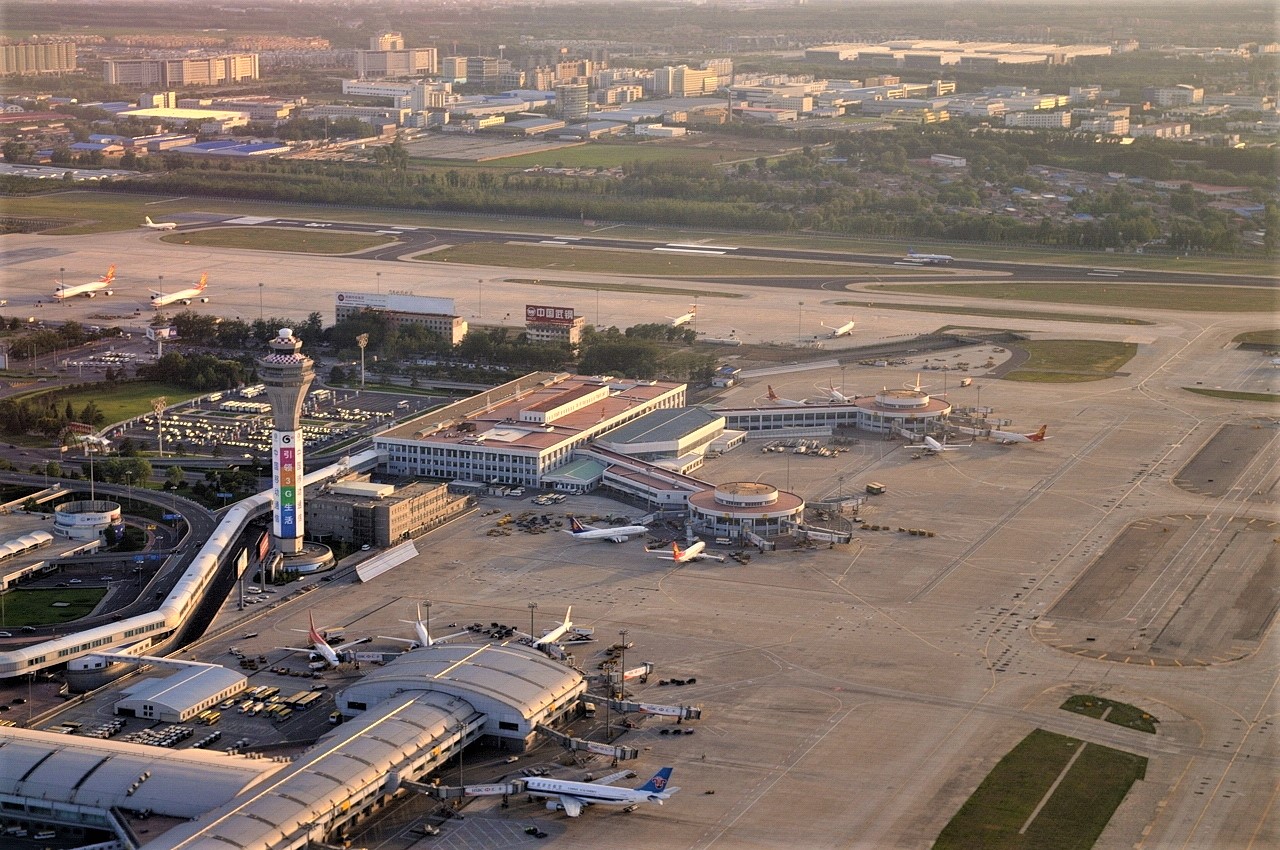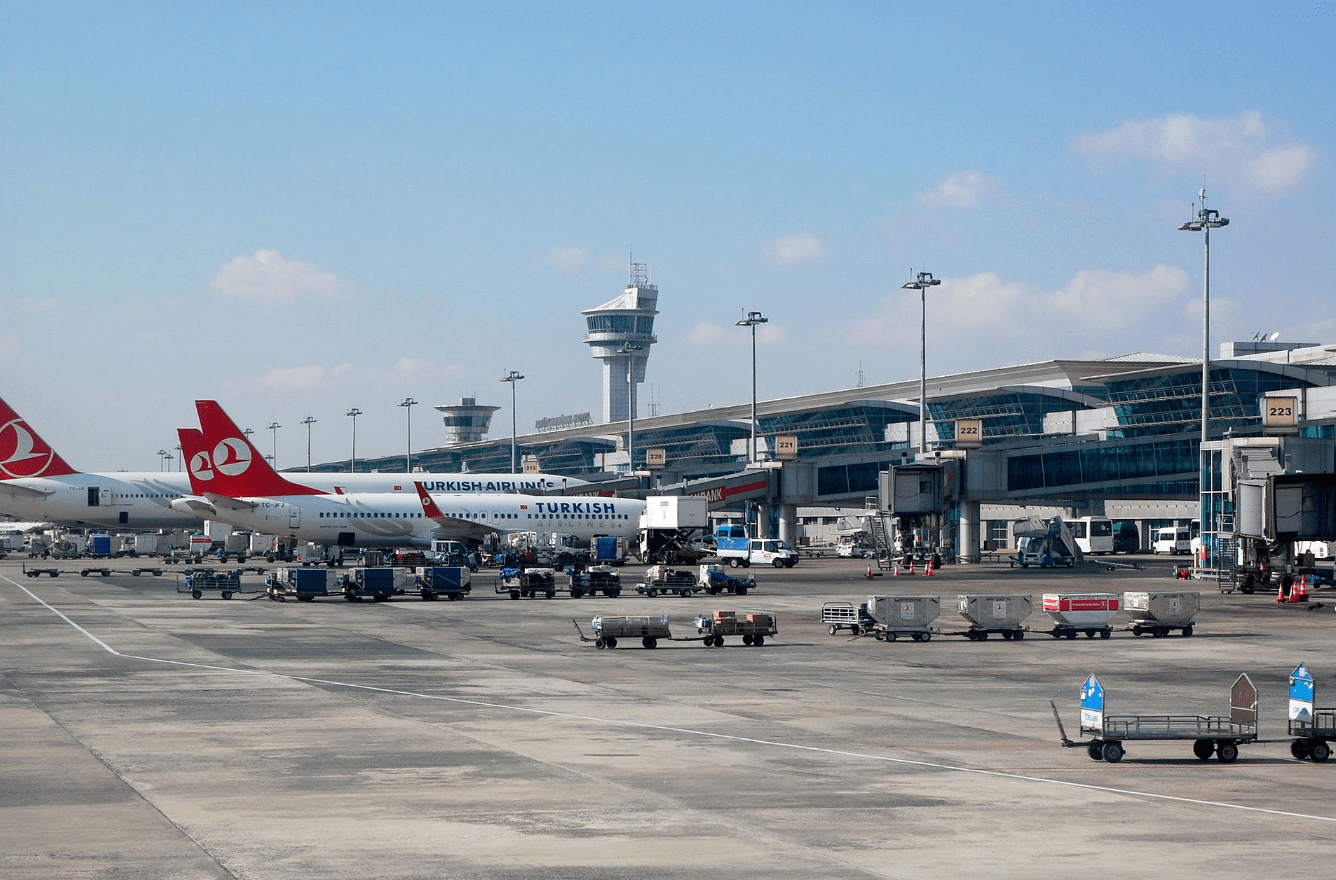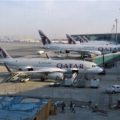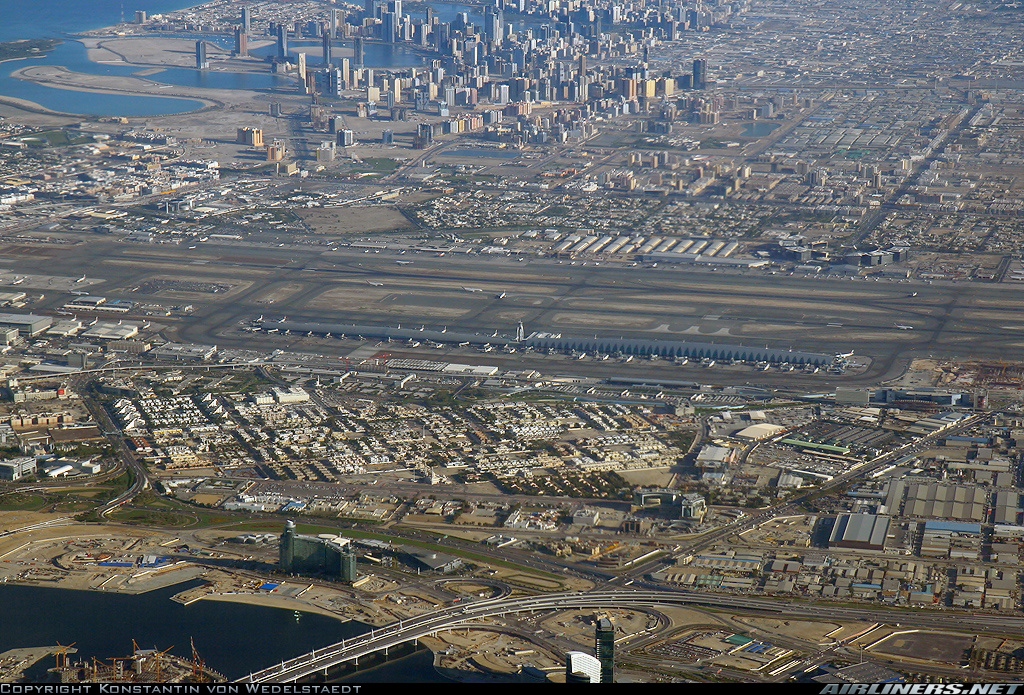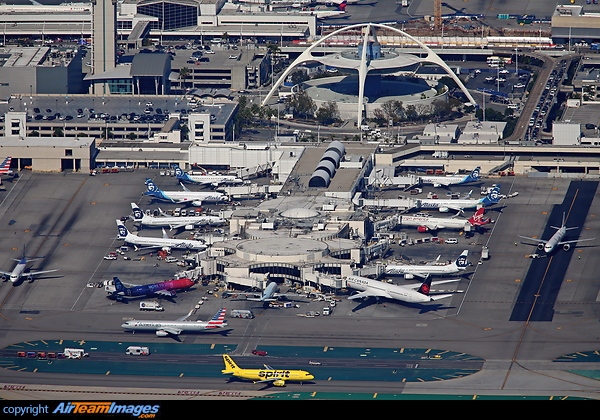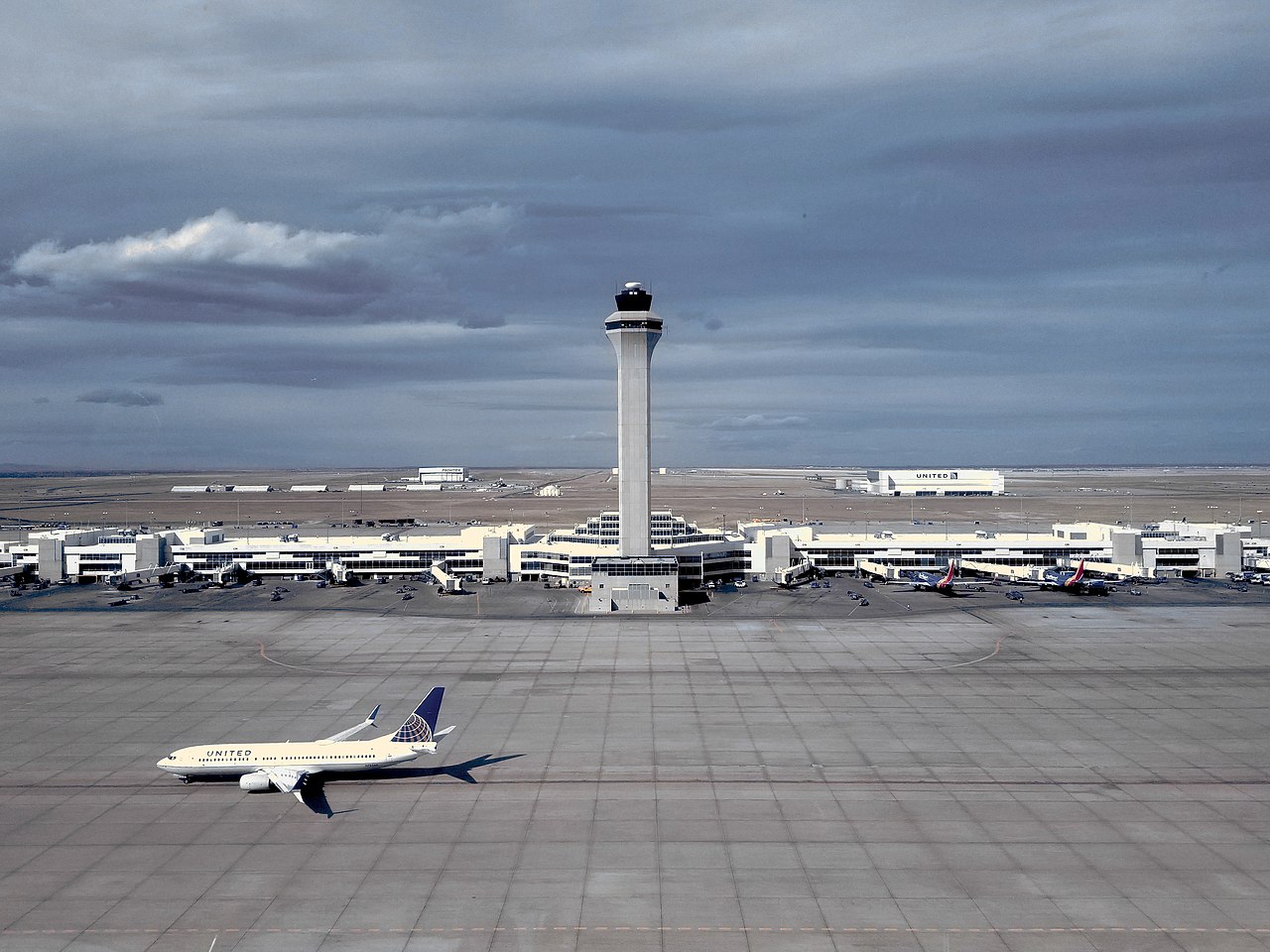Aviation
Mexico City International Airport

Source: Edgor Tovar Vmzp85
| IATA: MEX ICAO: MMMX LID: ME1 | |
| Airport type | Public |
| Owner | Grupo Aeroportuario de la Ciudad de México |
| Operator | Aeropuertos y Servicios Auxiliares |
| Serves | Mexico City, Mexico |
| Location | Venustiano Carranza, Mexico City |
| Hub for | Aeromar Aeroméxico Aeroméxico Connect Interjet Magnicharters Volaris AeroUnion (cargo) Mas Air (cargo) |
| Focus city for | Air France Cargo (cargo) VivaAerobús |
| Elevation AMSL | 7,316 ft / 2,230 m |
| Coordinates | |
| Website | aicm.com.mx |
Mexico City International Airport (Spanish: Aeropuerto Internacional de la Ciudad de México, AICM); officially Aeropuerto Internacional Benito Juárez (Benito Juárez International Airport) (IATA: MEX, ICAO: MMMX) is an international airport that serves Greater Mexico City. It is Mexico’s and Latin America’s busiest airport by passenger traffic and aircraft movements. The airport sustains 35,000 jobs directly and around 15,000 indirectly in the immediate area. The airport is owned by Grupo Aeroportuario de la Ciudad de México and operated by Aeropuertos y Servicios Auxiliares, the government-owned corporation, which also operates 22 other airports throughout Mexico. In recent years Toluca Airport has become an alternate airport.
This airport is served by 30 domestic and international passenger airlines and 17 cargo carriers. As the main hub for Mexico’s largest airline Aeroméxico (with Aeroméxico Connect), the airport has become a SkyTeam hub. It is also a hub for Aeromar, Interjet, Volaris, and a focus city for VivaAerobus. On a typical day, more than 100,000 passengers[3] pass through the airport to and from more than 100 destinations on four continents. In 2018, the airport handled 47,700,547 passengers, a 6.6% increase compared to 2017.
Operating near the limits of its capacity, calls for replacing the airport were announced in September 2014, with the proposed location to be built 16 kilometres (9.9 mi) north-northeast of the current airport, east of Ecatepec. In January 2019, construction of the new airport was cancelled.


Location
Located at the neighbourhood of Peñón de los Baños within Venustiano Carranza, one of the sixteen boroughs into which Mexico City is divided, the airport is 5 km (3.1 mi) east from Downtown Mexico City and is surrounded by the built-up areas of Gustavo A. Madero to the north and Venustiano Carranza to the west, south and east. As the airport is located on the east side of Mexico City and its runways run southwest-northeast, an airliner’s landing approach is usually directly over the conurbation of Mexico City when the wind is from the northeast. Therefore, there is an important overflying problem and noise pollution.
Lack of capacity and slot restrictions


Source: Norman L. Cullen
Aerial view of the airport before the construction of Terminal 2. The airport has suffered from a lack of capacity due to restrictions on expansion, since it is located in a densely populated area. In 2014, Mexican authorities established and declared a maximum capacity of 61 operations per hour with a total of 16 rush hours (7:00 –22:59). Another issue with the airport is the limitation that its two runways provide, for this reason, only government, military, commercial and specially authorised aircraft are allowed to use the airport. Private aircraft must use alternate airports, such as Lic. Adolfo López Mateos International Airport in Toluca, General Mariano Matamoros Airport in Cuernavaca, or Hermanos Serdán International Airport in Puebla.
Attempt to replace the airport


model of the New Mexico City airport.
Source: Lizette de la Garza
Construction of a new Mexico City international airport was announced by Mexican president Enrique Peña Nieto on September 2, 2014, who said that it would be “emblemático”: a national symbol, replacing the current Mexico City International Airport, which is at capacity. It was to have a single terminal of 6,000,000 square feet (560,000 m2) and six runways: two of 4.5 kilometres (2.8 mi; 15,000 ft) and four of 4 kilometres (2.5 mi; 13,000 ft). The architects were Sir Norman Foster and Fernando Romero, son-in-law of billionaire Carlos Slim and architect of the Soumaya Museum.
Construction was to take eight years, costing 120 or 169 billion Mexican pesos, about 9–13 billion U.S. dollars, depending on the source, on land already owned by the federal government in the Zona Federal del Lago de Texcoco, between Ecatepec and Atenco in the State of Mexico, about 10 km northeast of the current airport. The terminal was to be sustainable, aiming at a LEED Platinum certification. The project was cancelled on October 30, 2018 following a referendum. The costs of cancellation are estimated at over US$5 billion.
Terminals and facilities


Source: Vmzp85
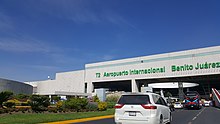

Source: Another Believer


Source: ProtoplasmaKid
Terminals
Mexico City International Airport has two passenger terminals. Terminal 1 is separated from Terminal 2 by the runways.
Terminal 1
- Opened in 1958; expanded in 1970, 1989, 1998, 2000 and 2004
- Overall terminal surface: 542,000 m2 (5,830,000 sq ft)
- Contact positions: 33
- Two contact positions equipped for the Airbus A380
- Remote positions: 17 (34 Before New T2 was built)
- Number of jetways: 33
- Number of airside halls: 10
- Number of landside (check-in) halls: 9
- Number of mobile-lounges: 11
- Hotel service:
- 600 room Camino Real
- 288 room Courtyard by Marriott
- 327 room Fiesta Inn (Located across from Terminal 1)
- 110 room Hilton
- Parking service: 3,100 vehicles (Domestic), 2,400 vehicles (International)
- Space per passenger in T1: 17 m2 (180 sq ft)
- Number of baggage claim carousels: 22
Terminal 2
- Opened in 2007
- Overall terminal surface: 288,000 m2 (3,100,000 sq ft)
- Contact positions: 23
- Remote positions: 18 (Aeromar and Aeroméxico Connect)
- Number of jetways: 23
- Number of airside halls: 2 (Domestic, International)
- Number of landside (check-in) halls: 3 (L1, L2, L3)
- Hotel service:
- 287 room NH
- Parking service: 3,000 vehicles
- Space per passenger in T2: 22 m2 (240 sq ft)
- Number of baggage claim carousels: 15)
- Platform surface: 426,000 m2 (4,590,000 sq ft)
- Inter-terminal Aerotrén capacity: 7,800 daily passengers
Terminal 2 was built over a surface area of 242,666.55m² and has modern security systems, in accordance with international standards including a passenger traffic separation systems. The new facility will help AICM increase its capacity to 32 million passengers per year.
Air operations in the new facilities began on November 15, 2007, with flights by Aeromar and Delta Air Lines, and later AeroMéxico, Copa, LAN and Continental Airlines. Terminal 2 was formally inaugurated by former Presidente Felipe Calderón Hinojosa on March 26, 2008.
These projects were done without affecting airplane takeoffs and landings, and will help Mexico City International Airport offer better services, and respond to the growing demand of passengers and operations in the coming years.
Terminal 2 now houses all Aeroméxico flights out of the airport, becoming the airline’s main distribution centre. Although the terminal was intended to be served by all-SkyTeam member airlines, Air France and KLM decided to remain at Terminal 1.
Terminal 3
The proposed construction of a Terminal 3 was canceled during the COVID-19 pandemic in Mexico. It is estimated that it will take three or four years to bring the number of flights back to 2019 levels, by which time the General Felipe Ángeles International Airport in Santa Lucía, Zumpango, State of Mexico will be open.
Other facilities
Aeropuertos y Servicios Auxiliares, a government-owned corporation that operates airports in Mexico, has its headquarters on the airport property., Aeropuertos y Servicios Auxiliares. The Aeromar headquarters are located in Hangar 7 in Zone D of the General Aviation Terminal of the airport. Aviacsa had its headquarters in Hangar 1 in Zone C, but ceased operations on May 4, 2011.
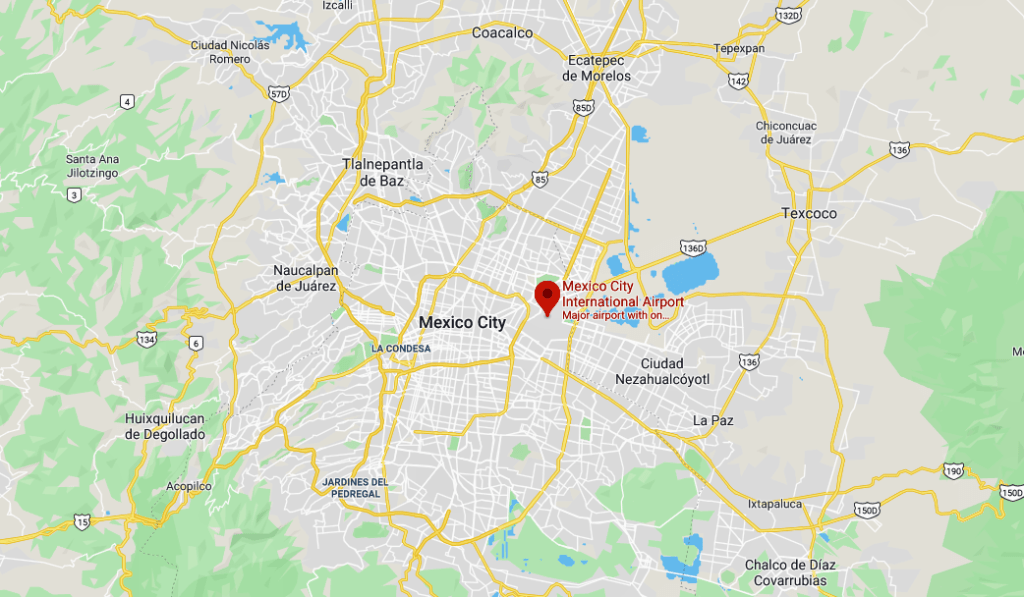

Airlines and destinations
The airport connects 52 domestic and 50 international destinations in Latin America, North America, Europe and Asia. Aeromexico serves the largest number of cities from any Latin American hub (80), 46 domestic and 34 international.[45] Most prominent foreign airlines are United Airlines, American Airlines, Delta Air Lines and Avianca Holdings. Aeroméxico/Aeroméxico Connect operates the most departures from the airport followed by Interjet, Volaris, and Aeromar. Aeroméxico also operates to the most destinations followed by Interjet.
Passenger
| Airlines | Destinations |
|---|---|
| Aeromar | Acapulco, Ciudad Victoria, Colima, Guadalajara, Ixtapa/Zihuatanejo, Ixtepec, Lázaro Cárdenas, Manzanillo, McAllen, Oaxaca, Piedras Negras, Poza Rica, Puerto Escondido, Puerto Vallarta, Saltillo, San Luis Potosí, Tamuín, Tepic, Veracruz |
| Aeroméxico | Amsterdam, Barcelona, Bogotá, Buenos Aires–Ezeiza, Cancún, Chicago–O’Hare, Chihuahua, Ciudad Juárez, Culiacán, Denver, Detroit, Guadalajara, Havana, Hermosillo, Las Vegas, Lima, London–Heathrow, Los Angeles, Madrid, Medellín–JMC, Mérida, Mexicali, Miami, Monterrey, Montréal–Trudeau, New York–JFK, Orlando, Paris–Charles de Gaulle, Puerto Vallarta, Quito, San Francisco, San José de Costa Rica, San José del Cabo, Santiago de Chile, São Paulo–Guarulhos, Seattle/Tacoma, Seoul–Incheon, Tijuana, Tokyo–Narita, Toronto–Pearson, Vancouver, Villahermosa |
| Aeroméxico Connect | Acapulco, Aguascalientes, Austin, Campeche, Cancún, Chetumal , Chihuahua, Ciudad del Carmen, Ciudad Juárez, Ciudad Obregón, Culiacán, Dallas/Fort Worth, Durango, Guatemala City, Hermosillo, Houston–Intercontinental, Huatulco, Ixtapa/Zihuatanejo, La Paz (Mexico), León/El Bajío, Los Mochis, Managua, Manzanillo, Matamoros, Mazatlán, Mérida, Minatitlán/Coatzacoalcos, Morelia, Nuevo Laredo, Oaxaca, Puerto Vallarta, Querétaro, Reynosa, San Antonio, San José del Cabo, San Luis Potosí, San Pedro Sula, San Salvador, Santo Domingo–Las Américas, Tampico, Tapachula, Torreón/Gómez Palacio, Tuxtla Gutiérrez, Veracruz, Villahermosa, Zacatecas |
| Air Canada | Vancouver |
| Air Canada Rouge | Toronto–Pearson Seasonal: Montréal–Trudeau |
| Air France | Paris–Charles de Gaulle |
| Alitalia | Rome–Fiumicino |
| All Nippon Airways | Tokyo–Narita |
| American Airlines | Charlotte, Dallas/Fort Worth, Los Angeles, Miami, Phoenix–Sky Harbor |
| Avianca | Bogotá |
| Avianca El Salvador | San Salvador |
| British Airways | London–Heathrow |
| Copa Airlines | Panama City |
| Cubana de Aviación | Havana |
| Delta Air Lines | Atlanta, Detroit, Los Angeles, Minneapolis/St. Paul, New York–JFK, Salt Lake City |
| Emirates | Barcelona, Dubai–International |
| Iberia | Madrid |
| Interjet | Acapulco, Bogotá, Campeche, Cancún, Cartagena, Chetumal, Chicago–O’Hare, Chihuahua, Ciudad del Carmen, Ciudad Juárez, Cozumel, Culiacán, Dallas/Fort Worth, Guadalajara, Guatemala City, Guayaquil, Havana, Hermosillo, Houston–Intercontinental, Huatulco, Ixtapa/Zihuatanejo, Las Vegas, León/El Bajío, Lima, Los Angeles, Mazatlán, Medellín–JMC, Mérida, Miami, Monterrey, Montréal–Trudeau, New York–JFK, Oaxaca, Orlando, Palenque, Puerto Escondido, Puerto Vallarta, Quito, San Antonio, San José de Costa Rica, San José del Cabo, San Salvador, Santa Clara, Tampico, Tijuana, Toronto–Pearson, Torreón/Gómez Palacio, Tuxtla Gutiérrez, Vancouver, Veracruz, Villahermosa Seasonal: Varadero |
| KLM | Amsterdam |
| LATAM Brasil | São Paulo–Guarulhos |
| LATAM Chile | Santiago de Chile |
| LATAM Perú | Lima |
| Lufthansa | Frankfurt, Munich |
| Magnicharters | Cancún, Huatulco, Ixtapa/Zihuatanejo, Mérida, Puerto Vallarta, San José del Cabo Seasonal: Cozumel, Manzanillo |
| Turkish Airlines | Istanbul1 |
| United Airlines | Chicago–O’Hare, Houston–Intercontinental, Newark, San Francisco, Washington–Dulles |
| VivaAerobus | Cancún, Chihuahua, Ciudad Juárez, Culiacán, Guadalajara, Hermosillo, Huatulco, Ixtapa/Zihuatanejo, Las Vegas, Mazatlán, Mérida, Monterrey, New York–JFK, Oaxaca, Puerto Escondido, Puerto Vallarta, Reynosa, San José del Cabo, Tijuana, Torreón/Gómez Palacio, Tuxtla Gutiérrez, Villahermosa, Zacatecas Charter: Havana, Varadero |
| Volaris | Acapulco, Aguascalientes, Cancún, Chetumal, Chicago–O’Hare, Chihuahua, Ciudad Juárez, Ciudad Obregón, Colima, Cozumel, Culiacán, Denver, Durango, Guadalajara, Hermosillo, Huatulco, Ixtapa/Zihuatanejo, La Paz, Las Vegas, León/El Bajío, Los Angeles, Los Mochis, Mazatlán, Mérida, Mexicali, Miami, Monterrey, Oakland, Oaxaca, Orlando, Puerto Escondido, Puerto Vallarta, San Antonio, San José del Cabo, San Luis Potosí, San Salvador, Tapachula, Tepic, Tijuana, Tuxtla Gutiérrez, Veracruz |
| Volaris Costa Rica | Guatemala City, San José de Costa Rica |
| Wingo | Bogotá |
Notes
^1 Turkish Airlines’s flight from Mexico City to Istanbul makes a stop in Cancún, however the airline doesn’t have local traffic rights between Mexico City and Cancún.
Other Services
In addition to the scheduled airlines above, Mexico City airport is used by some further airlines for chartered flights including:
- Global Air
- Sunwing Airlines
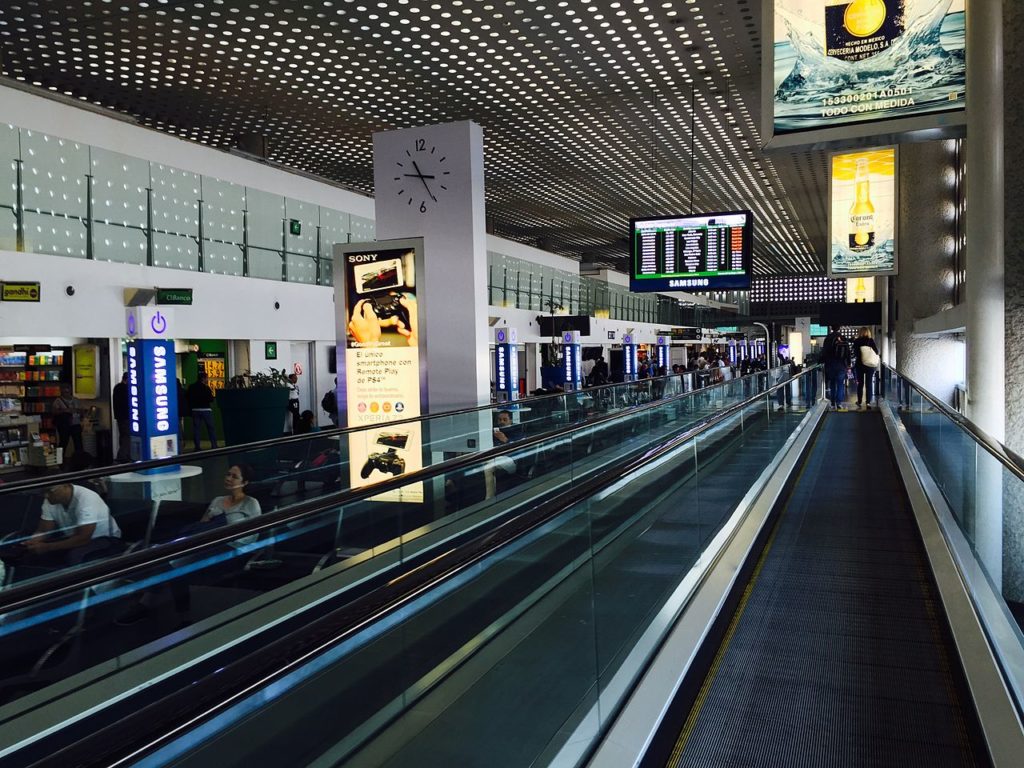

Source: Vmzp85
Cargo
As of January 2020, Mexico City airport is served by 21 cargo airlines flying directly to Europe, Central, North and South America, Middle East, Africa and East Asia. The following airlines operate the scheduled destinations below.
| Airlines | Destinations |
|---|---|
| ABX Air | Cincinnati, Guadalajara, Los Angeles |
| AeroUnion | Chicago–O’Hare, Cincinnati, Guadalajara, León/El Bajío, Los Angeles, Miami, Monterrey |
| Air France Cargo | Atlanta, Guadalajara, Houston–Intercontinental, Paris–Charles de Gaulle, Porto |
| Amerijet International | Miami |
| Atlas Air | Huntsville |
| Avianca Cargo | Bogotá |
| CAL Cargo Air Lines | Liège |
| Cargolux | Dallas/Fort Worth, Houston–Intercontinental, Los Angeles, Luxembourg, New York–JFK |
| Cargolux Italia | Milan–Malpensa |
| Cathay Pacific Cargo | Anchorage, Guadalajara, Hong Kong, Los Angeles |
| DHL Aviation | Cincinnati, Guadalajara, Los Angeles Seasonal: Guatemala City |
| Emirates SkyCargo | Copenhagen, Dubai–Al Maktoum, Frankfurt, Houston–Intercontinental, Los Angeles, Quito, Zaragoza |
| Estafeta Air Cargo | San Luis Potosí, Villahermosa Seasonal: Mérida |
| Ethiopian Airlines Cargo | Addis Ababa, Los Angeles, Miami, Zaragoza |
| Lufthansa Cargo | Chicago O’Hare, Dallas/Fort Worth, Frankfurt, Guadalajara, New York–JFK |
| Mas Air | Bogotá, Campinas–Viracopos, Caracas, Guadalajara, Guatemala City, Los Angeles, Manaus, Mérida, Miami, San José de Costa Rica |
| Qatar Airways Cargo | Atlanta, Doha, Houston–Intercontinental, Liège, Los Angeles, Luxembourg, Macau, Paris–Charles de Gaulle, Zaragoza |
| Turkish Airlines Cargo | Bogotá, Curaçao, Houston–Intercontinental, Istanbul–Atatürk, Maastricht, Madrid |
| UPS Airlines | Louisville |
Airlines providing on-demand cargo services
- Aeronaves TSM
- Air Cargo Carriers
- Air Transport International
- Ameristar Air Cargo
Inter-terminal transportation


transit with Terminal 2 in background.
Source: www.dcc.at
Terminal 1 is connected to Terminal 2 by the Aerotrén monorail system in which only connecting passengers with hand baggage are allowed to use with their boarding pass. Technical and cabin crew can also use it. The distance between the terminals is 3 km (1.9 mi). and the Airtrain’s speed is 45 km/h (28 mph). Also there is a land service between terminals called “inter-terminal transportation”. These buses are located at entrance no. 6 of Terminal 1 and entrance no. 4 of Terminal 2.
Ground transportation
Metro and bus services
Terminal 1 is served by the Terminal Aérea Metro station, which belongs to Line 5 of the subway, running from Pantitlán station to Politécnico station. It is located just outside the national terminal. Also, trolley bus line G runs from the bus stop next to the Metro to Boulevard Puerto Aéreo station 1.7 km (1.1 mi) away, allowing transfer to [[Metro Line 1 (one can also take line 5 to Pantitlán and change to line 1, which is a geographical detour). Terminal 2 does not have any Metro station, but is a 700 m (2,300 ft) walk from Pantitlán served by Metro lines 1, 5, 9, [[A and numerous local buses.
Terminals 1 and 2 have two land terminals operating 24 hours a day, 365 days a year. Different bus lines operate from here, and provide continuous transportation services to the main cities located around Mexico City, such as Córdoba, Cuernavaca, Pachuca, Puebla, Querétaro, Tlaxcala and Toluca.
Metrobús


terminals 1 and 2.
Source: ProtoplasmaKid
In late 2010, former Head of Government of the Federal District Marcelo Ebrard announced a plan to build a new Metrobús Line 4 that would run from near Buenavista Station in the west of the city towards Mexico City airport. Construction on Line 4 started on July 4, 2011. The plans for Line 4 included a two-step construction process with the first 28 km (17 mi) operational segment to be built between Colonia Buenavista and San Lázaro Metro station. An extension provides travel between San Lázaro and the airport. The line opened on April 1, 2012 with two stations, Terminal 1 and Terminal 2.
Authorized taxis
Taxis are in operation in Terminals 1 and 2 and there are two models of service: Ordinary service in a sedan type vehicle for 4 passengers. Executive service in 8 passengers vans. At present there are 5 taxi groups in operation. These are the only taxis authorised by the Ministry of Communications and Transport (SCT) of the Federal Government.
Accidents and incidents
- On April 10, 1968, an Aerovías Rojas Douglas R4D-3 crashed on approach, killing all eighteen people on board. The aircraft was operating a domestic scheduled passenger flight, which was the airline’s inaugural flight from Aguascalientes International Airport to Mexico City.
- On October 31, 1979, Western Airlines Flight 2605 crash-landed. The crew of the DC-10 landed on a closed runway and hit construction vehicles on the runway. There were 73 fatalities (including one on the ground) and 16 survivors.
- On December 12, 1981, a bomb exploded inside the passenger cabin of a parked Aeronica Boeing 727-100, tearing a hole into the fuselage. The captain, two flight attendants and a ground worker were injured. They had been on board the aircraft for pre-departure checks for a scheduled passenger flight to San Salvador and onwards to Managua’s Augusto C. Sandino International Airport.
- An Aero California DC-9-15 overran a runway on July 21, 2004, during an intense storm at the airport. There were no victims, but the aircraft was scrapped. However, a woman died later due to a heart attack.
- On November 4, 2008 a Mexican Interior Ministry LearJet 45 crashed on approach around 18:45 local time. On board were Mexican Secretary of the Interior Juan Camilo Mouriño, who was top aide to President Felipe Calderón. Mouriño was in charge of the fight against the drug trade in Mexico. Also on board was José Luis Santiago Vasconcelos, former assistant attorney general and current head of the federal technical secretariat for implementing the recent constitutional reforms on criminal justice and public security. All eight on board perished along with eight others on the ground. 40 others on the ground were injured. The crash was attributed to pilot error.
- On September 9, 2009, hijacked Aeroméxico Flight 576 landed at Mexico City International Airport from Cancún International Airport.
- On September 13, 2009, a Lufthansa Cargo McDonnell-Douglas MD-11 was damaged in a heavy landing. Post landing inspection revealed that there were wrinkles in the fuselage skin and the nose gear was bent.[62] According to a Lufthansa spokesman, the aircraft will be repaired and returned into full service
Source: wikipedia
